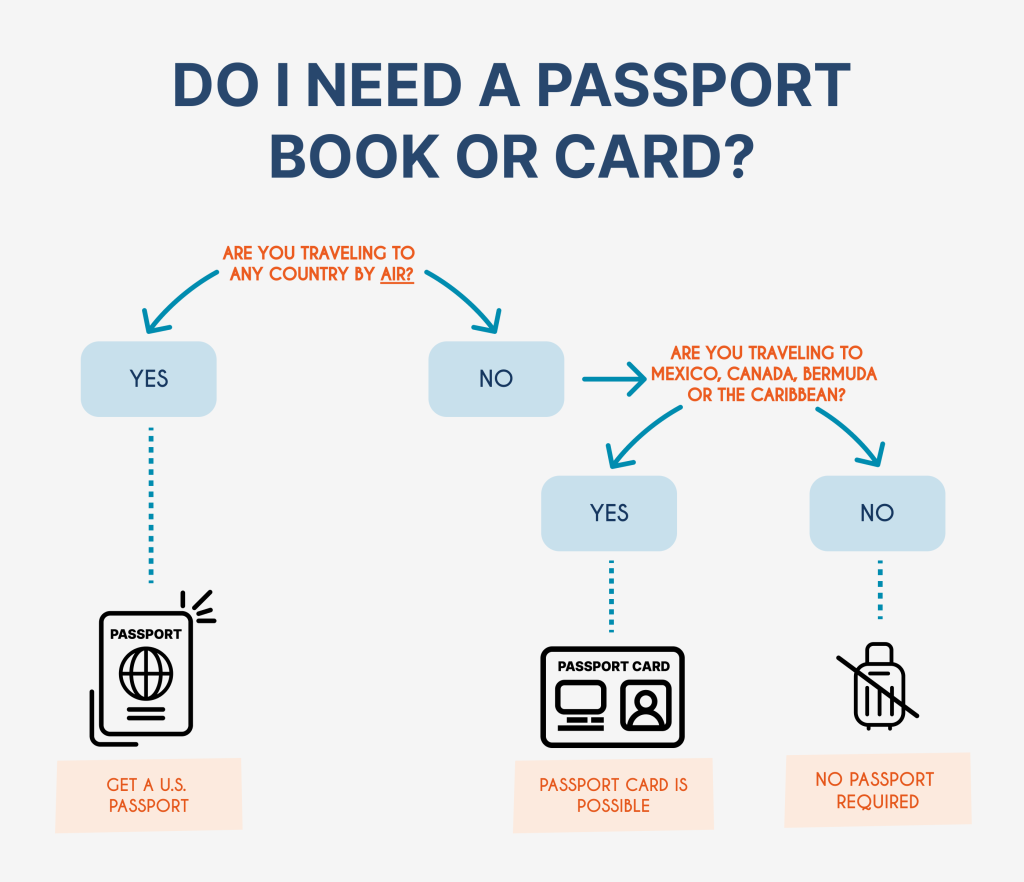When I got my first passport, I decided to get a passport card as well because, well, why not? Years later, well after my passport card expired, I can’t remember a single time I pulled out and used my card. Had I known more about the differences between a U.S. passport card and passport book, I would have skipped the extra fee.
While a U.S. passport is necessary when you are going to travel abroad by air, the uses of a U.S. passport card are narrower. In this guide, we will look at the key differences between the U.S. passport book vs card to help you decide which travel ID best suits your needs.
» Need to get a passport in two weeks or less? Read our guide on getting a passport fast.
In This Guide
![]()
What is a U.S. Passport Book?
A passport book is the traditional form of passport that allows you to travel internationally by air, land and sea. It includes pages for visas and entry/exit stamps and is now equipped with biometric technology.
Features of a Passport Book
- Size: Measures 5 × 3.5 inches.
- Pages: Contains multiple pages for stamps and visas.
- Biometric Features: Every non-expired passport is now a biometric passport. This means it includes an embedded microchip that stores biometric data, such as your digital photograph and other identifying information, to enhance security and reduce the risk of fraud.
- Security: Equipped with various security features to prevent fraud.
Where Can You Use a Passport Book?
- International Travel: Required for all international flights.
- Border Crossings: Valid at all land border crossings.
- Seaports: Necessary for international sea travel.
Cost and Validity
- First-time Application: $165 (including the execution fee).
- Renewal: $130.
- Validity: 10 years for adults, 5 years for minors.
Why Get a Passport Book?
- International Flights: Essential for air travel abroad.
- Versatility: Accepted worldwide for all types of travel.
- Necessary for Visas: Required for countries needing visa stamps.
Ready to get your first passport and unlock your ticket to traveling internationally? Read our step-by-step guide to the U.S. Passport Application Process.
What is a U.S. Passport Card?
A passport card is a wallet-sized travel document that provides a convenient alternative for specific types of travel. It is also a REAL ID-compliant ID issued by the U.S. Government.
Features of a Passport Card
- Size: Same as a credit card (3.3 × 2.1 inches).
- Appearance: Smaller and more portable than a passport book.
- Security: Includes a photo and personal information with security features.
- REAL ID Compliant: It can be used as a REAL ID, making it valid for domestic flights and entering federal facilities.
Where Can You Use a Passport Card?
- Land Border Crossings: Valid for land border crossings between the U.S. and Canada or Mexico.
- Sea Ports of Entry: Valid for travel by sea between the U.S. and Canada, Mexico, the Caribbean or Bermuda
- Domestic Flights: Can be used as an ID if your state is not REAL ID compliant.
Tip: When traveling to other overseas destinations, a passport card will not be accepted for any border crossings, BUT it still can often be used as a form of ID when you want to leave your passport behind in a safe location.
Cost and Validity
- First-time Application: $65 (including the execution fee).
- Renewal: $30.
- Validity: 10 years for adults, 5 years for minors.
Why Get a Passport Card?
- Convenience: Fits easily in your wallet.
- Cost-Effective: Cheaper than a passport book.
- Domestic Use: Useful as an ID if you don’t have a REAL ID-compliant driver’s license

If you are only traveling to Canada or Mexico by land or boat, a passport card can save you some money compared to a passport book.
Comparing U.S. Passport Book vs Card
Here’s a side-by-side comparison to help you understand the key differences:
Usage Scenarios
| Feature | Passport Book | Passport Card |
|---|---|---|
| International Air Travel | Yes | No |
| Land Border Crossings | Yes | Yes (Canada, Mexico) |
| Sea Ports of Entry | Yes | Yes (Canada, Mexico, the Caribbean, Bermuda) |
| Visa Pages | Yes | No |
| Domestic Flights | Yes | Yes (if your state ID is not REAL ID compliant) |
Both passport books and passport cards can be used at Ready Lanes for faster border processing.
Size and Convenience
| Feature | Passport Book | Passport Card |
|---|---|---|
| Size | 5 × 3.5 inches | 3.3 × 2.1 inches |
| Portability | Less portable | Fits in a wallet |
Costs
| Feature | Passport Book | Passport Card | Passport Book & Card |
|---|---|---|---|
| Adult First-time Fee | $165 | $65 | $195 |
| Adult Renewal Fee | $130 | $30 | $160 |
| Minors 16-17 | $165 | $65 | $195 |
| Minors Under 15 | $135 | $50 | $150 |
Learn more: How Much Does a U.S. Passport Cost? Passport Fees Explained
Processing Times
- Routine: 4–6 weeks for both.
- Expedited: 2–3 weeks for an additional $60.
- Shipping: 1–2-day shipping is only available for passport books, not cards.
Learn more about Expedited Passport Services.


